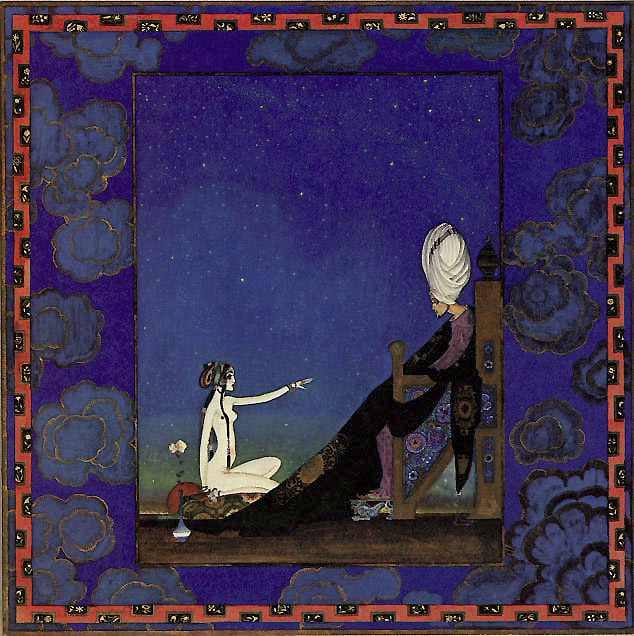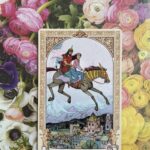” … and I have only my heart, that is my own, to offer you. But what am I saying? My own? Alas, my princess, my love, it was all and only yours from the first moment I beheld you!”
~ The Ebony Horse, 1001 Nights
Listening to Scheherazade spin words into stories into magic, night after night, was a much loved and enchanting experience for me as a child. I travelled the oceans and seas and distant lands with Sinbad; I learned the importance of paving our own luck and paths with kindness and patience of rhythm with Ma’ruf the Shoemaker; I dreamed of love and danced of love under moonlit skies to the lyrics of heart between Aladdin and princess Badroulbadour; I searched the caves of treasures and outwit the forty thieves with Ali Baba; and then I fell into trust and into love, letting life guide me upon the wings of divine timing, fate and destiny with the enchanted ebony horse.
And all the while, what I was perhaps truly learning was the importance of words and storytelling. Words are mini Gods. We weave prayers with our words, and words become us; we weave ourselves of stories – stories of the heart, and stories with voices older than us, older than time, from a time before time beyond time.
We may think we tell stories, but it is often stories telling us. They tell us to love or to hate, they tell us to see or to stay blind. They becomes our geographies and landscapes of the unique emotional and spiritual wildlands. Within them, we expand or contract, we build borders or transcend them through our infinite imaginations and travels of the mind and heart. We create sanctuaries or prisons, we create pathways or conditions. The task of learning to be free requires us to learn to listen, and to hear the silent wisdom that stories teach and weave beneath the souls of our feet.
Words are powerful, they are mini Gods. Every day we make the choice to speak love or not, to encourage someone or not. We make a choice on what kind of prayer we want to weave ourselves into, and on the kind of change we want to make in someone’s life, and all of our world.
In our modern day we have forgotten how to speak. Most of our communication has been reduced to memes, emojis and half pronounced words like saying “gorg” instead of gorgeous. We are even more tempted to say lol than actually, well, laugh. I recently watched on television a woman in her 20s whose every forth word was “like”, and as much I tried to follow, I had no idea where each sentence began or ended, what she was saying and what she even wanted to say or express emotionally. Worse yet, by the end of her monologue, I had began to repeat “like” like a parrot too.
And then the next day I watched a little girl, perhaps six or so, browsing the local fresh market with her parents, who suddenly stopped in complete wonderment with big wide beautiful eyes to say: Wow, what deliciously looking strawberries! The next time we went shopping, we were inspired to buy our own deliciously looking strawberries. They were deliciously tasting also. And how beautiful is that? To describe things.
What I find most sad though is that there is no longer much meaning and weight to words. My word is my bond is no longer. There are no emotions, no heart, no integrity, and without meaning what is the purpose to speaking anyway? It’s like a spiritual poverty that has come upon humanity, that has now become poverty of true connection – and the way we speak and our words are clearly reflecting these societal issues. There is little to no alignment between words and actions; it is accepted and almost expected and normalized for people to say one thing yet do another. Words have become empty, memorized, over-used to the point of being robbed of their true essence, disconnected, robotic, and weightless.

1001 Nights illustrated by Maxfield Parrish
About 1001 Nights and the magic of Scheherazade:
One Thousand and One Nights is a collection of Middle Eastern folk tales compiled in Arabic during the Islamic Golden Age. The work was collected over many centuries by various authors, translators, and scholars across West Asia, Central Asia, South Asia, and North Africa. Some tales trace their roots back to ancient and medieval Arabic, Egyptian, Sanskrit, Persian, and Mesopotamian literature. Many tales were originally folk stories from the Abbasid and Mamluk eras, while others, especially the frame story between Shahryar and Scheherazade, are probably drawn from the Pahlavi Persian work and translations of older Indian texts.
Common to all the editions of the Nights is the framing story between the kingdom’s ruler Shahryar who has gone mad from the betrayal of his brother’s wife; so of fears and desire for vengeance he decides to kill all women in the court. He marries them, and kills them in the morning. To escape her death, the witty and enormously talented Scheherazade decided to weave Shahryar in a cocoon of never-ending anticipation as she tells him a story each night.

“What is your last wish dear Scheherazade,” he asked her. “I wish to tell you a tale, my king, but I can only tell my tales at night.” Night came and she began, and as sun kissed the arms of dawn she stopped her tale before it was finished. Deeply curious, Shahryar postponed her fate, so that he’d hear the tale’s end. But after the tale’s end, surprise, surprise, she’d weave another new tale as still the moon was high in sky.
And so it went, night after night, she’d weave and spin stories one from the other; and then another tale another night, until one thousand and one nights. Words softened his heart, love healed him. And somewhere along the way they both mutually fell in love, and she bore him children.
What many people don’t know is that the famous tales of Ali Baba and Aladdin weren’t part of the original texts. These tales and many others first appeared in Les mille et une nuits, contes arabes traduits en français (“The Thousand and One Nights, Arab stories translated into French”) – a collection of tales published in 12 volumes between 1704 and 1717 by French translator Antoine Galland. Galland collected and translated various tales and stories not only from the original manuscripts, but also from other older folk tales from these regions; and so his collection includes many tales such as Ali Baba and Aladdin, which hadn’t appeared in print before.

1001 Nights illustrated by Hans Zatzka
Galland had come across a manuscript of The Tale of Sunbad the Sailor in Constantinople during the 1690s, and in 1701 he published his French translation of it.
Its success encouraged him to embark on a translation of a 14th-century Syrian manuscript of tales from The Thousand and One Nights and then delve deeper into finding and translating other older folk tales from those regions.
For example, the tale of Aladdin is a Middle-Eastern folk tale that Galland had heard from the Syrian Maronite storyteller Hanna Diyab.
This was the first tale from 1001 Nights that I heard as a child, and it became my magical entry into the world of nightly storytelling. I was enchanted by the love between Aladdin and princess Badroulbadour, whose name means full moon or full moons, as a metaphor for female beauty and grace – and to also signify the changing waves and natural seasons that both love and life go through.
The art of storytelling:
The art of storytelling is one of the most important women’s ancient arts. Women had to learn how to speak and to communicate with wisdom, delicacy and gentleness. This was a great talent and skill, which helped not only their own self-development but all of their relationships also. In many cultures, storytelling is an art of seduction also. Think of the geishas in Japan – they learned all arts of beauty and yet their most important skill was in holding conversations with intelligence, being well rounded and multi-cultured.
Education is important for women, and knowing how to express ourselves and speak and communicate are skills that we can apply in everything to live more fulfilling lives. We’ll raise our children with our words; we ‘ll have better relationships because of our communication; and we’ll know how to communicate with our own selves also.

1001 Nights illustrated by Kay Nielsen
This feminine art comes with the knowledge of the rules of the conversation where a woman can increase the interest of a person she talks to or on the contrary, to subtly change the subject; she learns how to initiate a conversation, to draw boundaries, and to avoid potential arguments.
The art of gestures is a part of that teaching also, as movements are ways of communication and expression that dance beautifully with words.
The art of ethics was another very important art regarding communication. A woman had to know not to gossip or speak badly about other women behind their back, as well as practice good moral, discernment and good manners towards her own thoughts, words and actions. This is about having ethics, higher values and integrity.
It is also learning to control your emotional speeches, so that you are trustworthy, your words carry weight and meaning, and you are delicate enough not to break the Universal laws of harmony and morality.
The art of communication also included knowing how to write properly and remain respectful of other cultures and foreign languages. It was preferable for a woman to educate herself on foreign language and be worldly cultured.
There was also the art of aesthetics which was the knowledge of beauty and harmony in every type of art, in daily life, and in our own physical appearance. Essentially this is about our ability to see the beauty in nature, and the ability to express your impressions into words, images or visuals. The more we are able to see beauty in the simple things, the more we’ll be able to recognize it everywhere.

The Ebony Horse illustrated by John D. Batten
The power of words:
Words are powerful, and words are essentially our faith embodied. It’s like prayer. And we pray ourselves into being each and every day. We pray when we cook, when we speak, when we move, when we write, when we dance, when we create, when we love and when we believe. But usually, these are unconscious. In every word is the potential energy and the power to expand or contract our experience forward. Ultimately, our words, whether spoken consciously or unconsciously, whether towards ourselves or others, become our thought patterns which then become our behavioural patterns, and then – our physical movements, gestures and experiences. This is why it is really important to be mindful of what words we use as our way of language. With our modern day use of shallow words, and words filled with ugliness, ignorance and vulgarity – or just surface level expressions through memes and emojis – we are only limiting ourselves further. We need to learn and awaken ourselves into the art of language. We can live our life as a prayer. We can weave letters like pearls, beauty of words into a necklace of love and of inspiration. Isn’t that magic?

For more of my writings, browse through my Art of Love.
If you wish to support me and my work, you may do so by sharing it or donate here. For personal readings with me, you may visit my Offerings.
Your support means so much to me! Thank you wholeheartedly!
Cover artwork by Kay Nielsen from his illustrations of 1001 Nights.




